Intel's 10nm Cannon Lake and Core i3-8121U Deep Dive Review
by Ian Cutress on January 25, 2019 10:30 AM ESTStock CPU Performance: System Tests
Our System Test section focuses significantly on real-world testing, user experience, with a slight nod to throughput. In this section we cover application loading time, image processing, simple scientific physics, emulation, neural simulation, optimized compute, and 3D model development, with a combination of readily available and custom software. For some of these tests, the bigger suites such as PCMark do cover them (we publish those values in our office section), although multiple perspectives is always beneficial. In all our tests we will explain in-depth what is being tested, and how we are testing.
All of our benchmark results can also be found in our benchmark engine, Bench.
Application Load: GIMP 2.10.4
One of the most important aspects about user experience and workflow is how fast does a system respond. A good test of this is to see how long it takes for an application to load. Most applications these days, when on an SSD, load fairly instantly, however some office tools require asset pre-loading before being available. Most operating systems employ caching as well, so when certain software is loaded repeatedly (web browser, office tools), then can be initialized much quicker.
In our last suite, we tested how long it took to load a large PDF in Adobe Acrobat. Unfortunately this test was a nightmare to program for, and didn’t transfer over to Win10 RS3 easily. In the meantime we discovered an application that can automate this test, and we put it up against GIMP, a popular free open-source online photo editing tool, and the major alternative to Adobe Photoshop. We set it to load a large 50MB design template, and perform the load 10 times with 10 seconds in-between each. Due to caching, the first 3-5 results are often slower than the rest, and time to cache can be inconsistent, we take the average of the last five results to show CPU processing on cached loading.
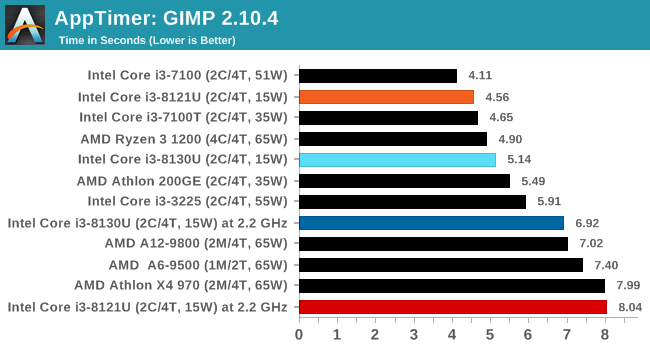
The CNL platform here does particularly well in loading software, which correlates with what I felt actually using the system - it felt faster than some Core i7 notebooks I've used. This might be down to the GPU acting on the display however. But it doesn't explain the extreme regression when we fix the clock speed.
FCAT: Image Processing
The FCAT software was developed to help detect microstuttering, dropped frames, and run frames in graphics benchmarks when two accelerators were paired together to render a scene. Due to game engines and graphics drivers, not all GPU combinations performed ideally, which led to this software fixing colors to each rendered frame and dynamic raw recording of the data using a video capture device.
The FCAT software takes that recorded video, which in our case is 90 seconds of a 1440p run of Rise of the Tomb Raider, and processes that color data into frame time data so the system can plot an ‘observed’ frame rate, and correlate that to the power consumption of the accelerators. This test, by virtue of how quickly it was put together, is single threaded. We run the process and report the time to completion.
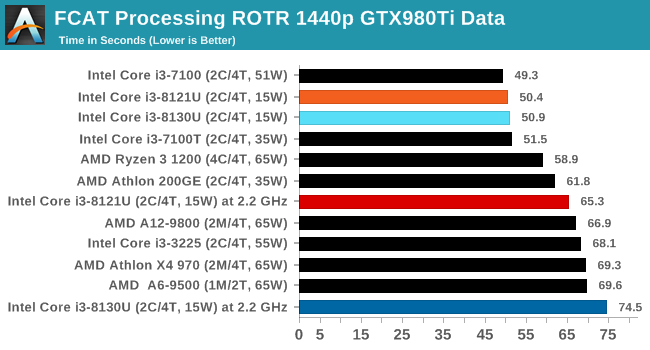
At stock speeds, both of our CNL and KBL chips score within half a second of each other. At fixed frequency, CNL comes out slightly ahead.
3D Particle Movement v2.1: Brownian Motion
Our 3DPM test is a custom built benchmark designed to simulate six different particle movement algorithms of points in a 3D space. The algorithms were developed as part of my PhD., and while ultimately perform best on a GPU, provide a good idea on how instruction streams are interpreted by different microarchitectures.
A key part of the algorithms is the random number generation – we use relatively fast generation which ends up implementing dependency chains in the code. The upgrade over the naïve first version of this code solved for false sharing in the caches, a major bottleneck. We are also looking at AVX2 and AVX512 versions of this benchmark for future reviews.
For this test, we run a stock particle set over the six algorithms for 20 seconds apiece, with 10 second pauses, and report the total rate of particle movement, in millions of operations (movements) per second. We have a non-AVX version and an AVX version, with the latter implementing AVX512 and AVX2 where possible.
3DPM v2.1 can be downloaded from our server: 3DPMv2.1.rar (13.0 MB)
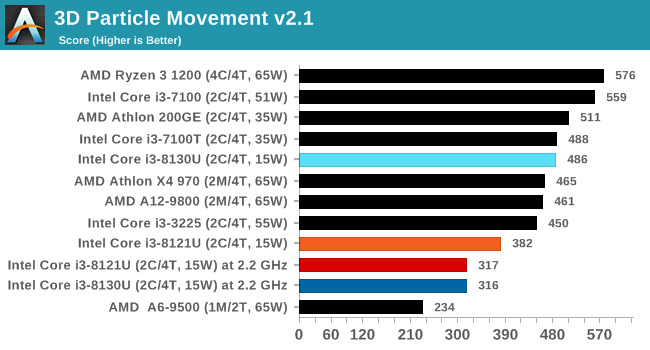
When AVX isn't on show, the KBL processor takes a lead, however it is worth nothing that at fixed frequency both CNL and KBL perform essentially the same.
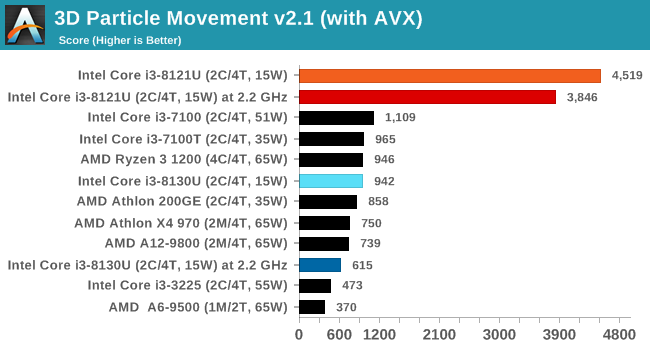
When we crank on the AVX2 and AVX512, there is no stopping the Cannon Lake chip here. At a score of 4519, it beats a full 18-core Core i9-7980XE processor running in non-AVX mode which scores 4185. That's insane. Truly a big plus in Cannon Lake's favor.
Dolphin 5.0: Console Emulation
One of the popular requested tests in our suite is to do with console emulation. Being able to pick up a game from an older system and run it as expected depends on the overhead of the emulator: it takes a significantly more powerful x86 system to be able to accurately emulate an older non-x86 console, especially if code for that console was made to abuse certain physical bugs in the hardware.
For our test, we use the popular Dolphin emulation software, and run a compute project through it to determine how close to a standard console system our processors can emulate. In this test, a Nintendo Wii would take around 1050 seconds.
The latest version of Dolphin can be downloaded from https://dolphin-emu.org/
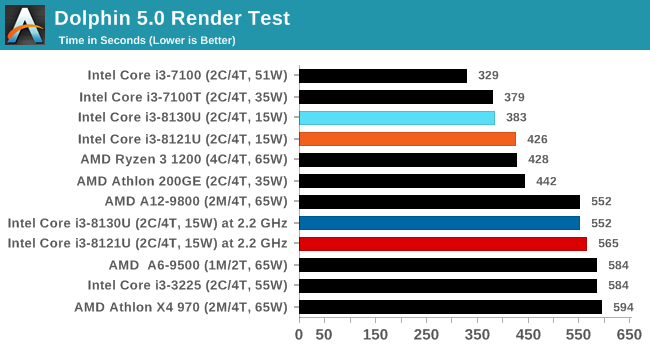
Both CPUs perform roughly the same at fixed frequency, however KBL has a slight lead at stock frequencies, likely due to its extra 200 MHz and ability to keep that frequency regardless of what's running in the background.
DigiCortex 1.20: Sea Slug Brain Simulation
This benchmark was originally designed for simulation and visualization of neuron and synapse activity, as is commonly found in the brain. The software comes with a variety of benchmark modes, and we take the small benchmark which runs a 32k neuron / 1.8B synapse simulation, equivalent to a Sea Slug.
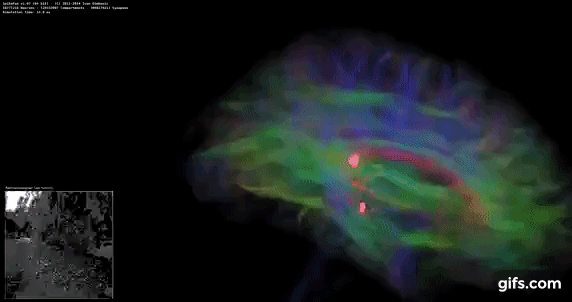
Example of a 2.1B neuron simulation
We report the results as the ability to simulate the data as a fraction of real-time, so anything above a ‘one’ is suitable for real-time work. Out of the two modes, a ‘non-firing’ mode which is DRAM heavy and a ‘firing’ mode which has CPU work, we choose the latter. Despite this, the benchmark is still affected by DRAM speed a fair amount.
DigiCortex can be downloaded from http://www.digicortex.net/
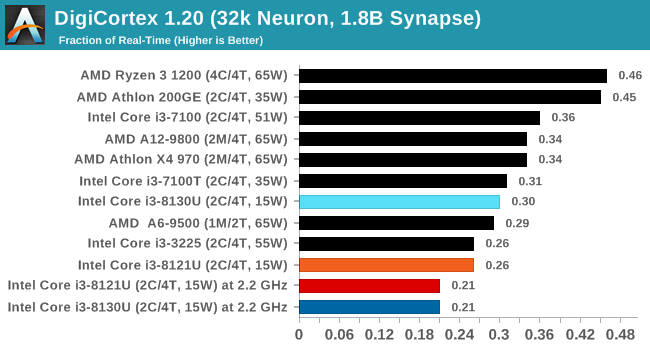
At a fixed frequency, both processors perform the same, but at stock frequencies the lower DRAM latency means that the Cannon Lake CPU only improves a little bit, whereas the Kaby Lake adds another 50% performance.
y-Cruncher v0.7.6: Microarchitecture Optimized Compute
I’ve known about y-Cruncher for a while, as a tool to help compute various mathematical constants, but it wasn’t until I began talking with its developer, Alex Yee, a researcher from NWU and now software optimization developer, that I realized that he has optimized the software like crazy to get the best performance. Naturally, any simulation that can take 20+ days can benefit from a 1% performance increase! Alex started y-cruncher as a high-school project, but it is now at a state where Alex is keeping it up to date to take advantage of the latest instruction sets before they are even made available in hardware.
For our test we run y-cruncher v0.7.6 through all the different optimized variants of the binary, single threaded and multi-threaded, including the AVX-512 optimized binaries. The test is to calculate 250m digits of Pi, and we use the single threaded and multi-threaded versions of this test.
Users can download y-cruncher from Alex’s website: http://www.numberworld.org/y-cruncher/
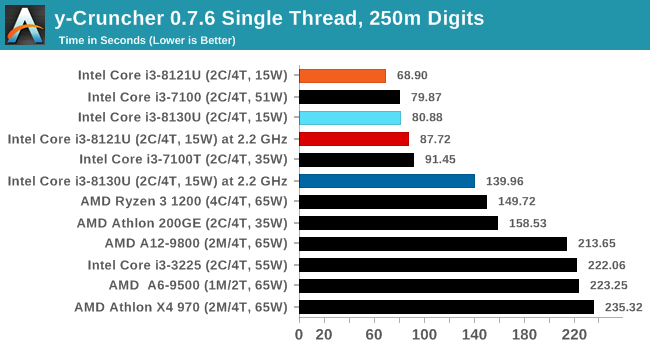
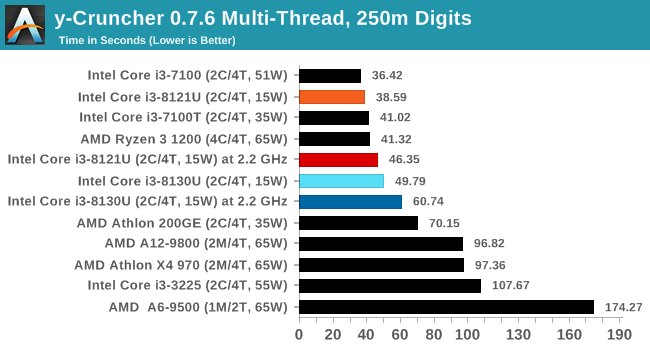
y-Cruncher is another AVX-512 test, and in both ST and MT modes, Cannon Lake wins. Interestingly in MT mode, CNL at 2.2 GHz scores better than KBL at stock frequencies.
Agisoft Photoscan 1.3.3: 2D Image to 3D Model Conversion
One of the ISVs that we have worked with for a number of years is Agisoft, who develop software called PhotoScan that transforms a number of 2D images into a 3D model. This is an important tool in model development and archiving, and relies on a number of single threaded and multi-threaded algorithms to go from one side of the computation to the other.
In our test, we take v1.3.3 of the software with a good sized data set of 84 x 18 megapixel photos and push it through a reasonably fast variant of the algorithms, but is still more stringent than our 2017 test. We report the total time to complete the process.
Agisoft’s Photoscan website can be found here: http://www.agisoft.com/
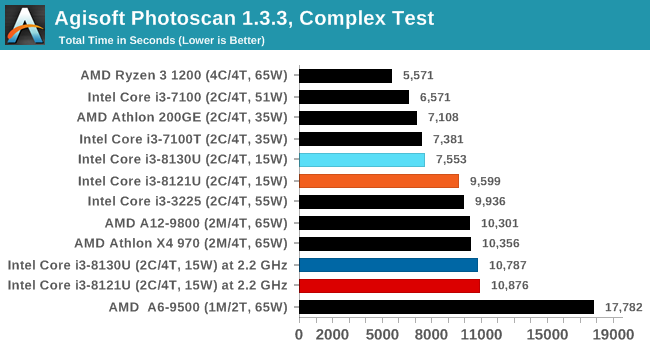
KBL takes a big lead here at stock frequencies, while at fixed frequencies the results are similar. We might be coming up against the power difference here - the KBL system has a higher steady state power limit.












129 Comments
View All Comments
KOneJ - Sunday, January 27, 2019 - link
Bingo.Spunjji - Tuesday, January 29, 2019 - link
Truly magnificent.KateH - Saturday, January 26, 2019 - link
but please, if OP is interested in taking a whack at "articulating" i'd love to see what that looks like and how my translation faredMidwayman - Friday, January 25, 2019 - link
Interesing. So Basically no real possibility for desktop improvement until 2020 at least. They really are giving AMD a huge window to take the performance crown. Zen 2 is due to ship this year, right?BigMamaInHouse - Friday, January 25, 2019 - link
And dont forget- there are many Dual/Quad core (lets Say from Q6600 ~SandyBridge to 7700K ) Intel PC's that gonna be upgraded finally with new Ryzen launch and those PC won't we upgraded for another 3+ Years,DanNeely - Sunday, January 27, 2019 - link
The lower end of that range has been upgrading for years. The upper end has no real reason to upgrade unless they're doing something other than gaming, since current games don't benefit from the higher core counts much.I'm in the middle with a 4790K; and still see myself on track for a nominal 2022 upgrade; short of games growing CPU demands significantly or unexpected hardware failures I don't see any need to bring it forward. The additional cores will be nice for future proofing; but what I'm mostly looking forward to is all the stuff outside the CPU.
My notional want list is 10GB ethernet, PCIe4(5?) to the GPU and SSD, 50/50 USB 3.x A/C mix, and DDR5. The first of these is starting to show up on halo priced mobos.
PCIe4 is rumored to be launching this year on AMD, although from the leaks so far it's not clear if it'll only reach the first x16 slot for the GPU or be more widely available (maximum trace lengths are short enough that anything other than M.2 on a not-dimm will probably need signal boosters increasing costs).
Dual USB-C is starting to show up on a few boards; but widerspread availability is likely to be blocked until the hardware to handle flipping the connector moves from a separate chip into the chipset itself.
DDR5 is supposed to start shipping in very limited quantities this year, but will be another year or two before reaching consumer devices.
My guess is late 2020/early 2021 before all the hardware I want is finally available; which fits well with the nominal 8y lifespan I'm targeting for my systems core components.
shadowx360 - Friday, February 1, 2019 - link
What is the point of DDR5? It's going to be beyond overpriced at launch for negligible performance gain. As for USB-C, you can find cases with front connectors.Gondalf - Friday, January 25, 2019 - link
Ask to TSMC, we have not any real date of shipment. Moreover we don't know how the new SKUs will perform.eastcoast_pete - Saturday, January 26, 2019 - link
I don't think TSMC would give anybody except their customer (AMD) an expected shipping date. Also, while we don't know how the new AMD processors will perform, we already know that I Intel's 10 nm tech was both late and hasn't performed so we'll. BTW, I am currently running all PCs around me on Intel chips, so no fanboy here. This disappointing 10 nm fiasco is bad for all of us, as we need Intel to egg on AMD and vice versa. If one of them drops behind, the other one gets lazy.eastcoast_pete - Saturday, January 26, 2019 - link
Damn autocorrect and no edit!